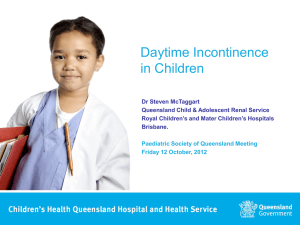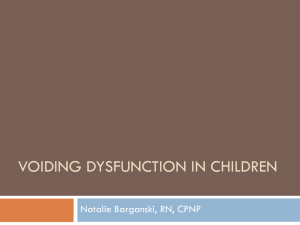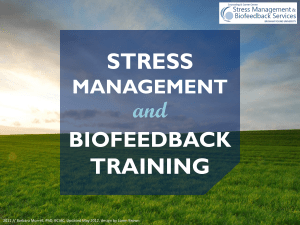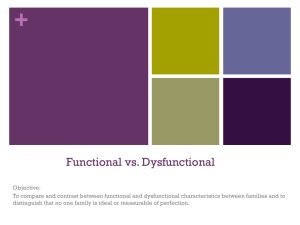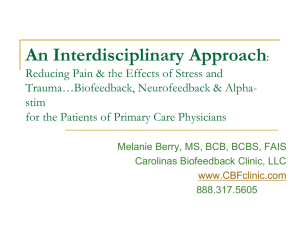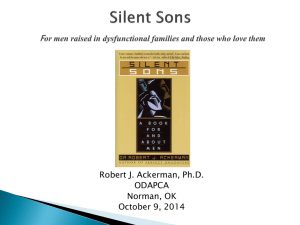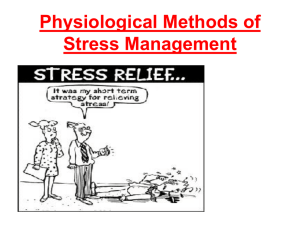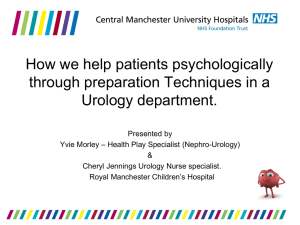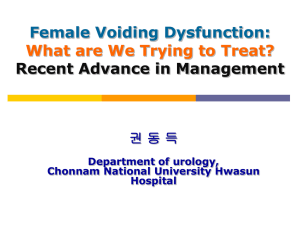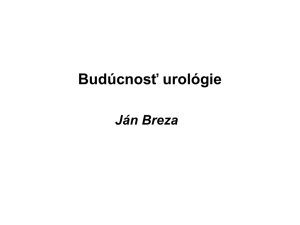Dysfunctional Elimination Syndromes 2
advertisement
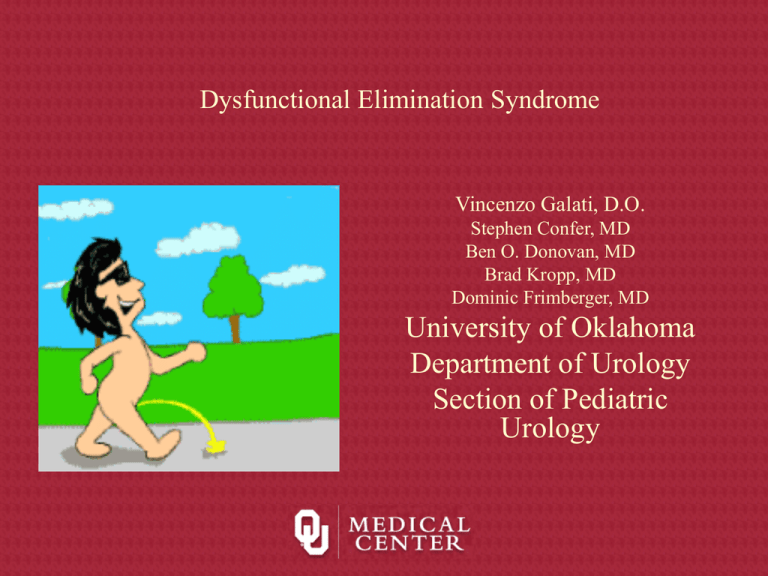
Dysfunctional Elimination Syndrome Vincenzo Galati, D.O. Stephen Confer, MD Ben O. Donovan, MD Brad Kropp, MD Dominic Frimberger, MD University of Oklahoma Department of Urology Section of Pediatric Urology Objectives • • • • • Normal Elimination Dysfunctional Elimination Syndrome Non-Neurogenic Neurogenic Bladder Biofeedback Review of the literature Development of Urinary Control • Infancy: Reflex voiding – Detrusor contracts when bladder full – External urinary sphincter contracts during filling • Voiding pattern in infants (feeding) • Development of continence – ↑ capacity and control of striated sphincter – Control over spinal micturition reflex Stooling • Normally – – – – – Newborn meconium passes w/in 24 hrs First few weeks: BMs 6 X q day By 5 months: BMs 3 X q day Age 2: BMs bid Age 4: BM q day J.W. Chase, Y. Homsy, C. Siggaard, F. Sit, and W.F. Bower. Functional Constipation in Children. J of Urology. 2004;171, 2641-2643. Dysfunctional Elimination • • • • Unknown etiology Abnormal elimination pattern Bowel or bladder incontinence Withholding maneuvers Holding Maneuvers Dysfunctional Elimination • Prevalence approximately 15% (Hellstrom et al. 1991) • Overlooked factor in pediatric UTIs • 40% of toilet trained with 1st UTI • 80% with recurrent UTI • Risk factor for VUR and renal scarring Bad Bladder Habits • • • • Infrequent visits to bathroom Inadequate time in bathroom Bad posture Poor hygiene What Happens? • Infrequent voiding – Over distended bladder • Failure to relax pelvic floor – Voiding against closed sphincter • ↑ PVR What Happens? • Bad posture – Can’t relax • Bad hygiene or aggressive soaps – Dysuria and incomplete voiding •Children rated wetting themselves at school as the third most catastrophic event behind losing a parent and going blind. Ollendick et al, Behav Res Therapy, 1989. Functional Bowel Disturbances • Constipation – Hard BM occurring < 3 X per week • Most likely to occur in 3 situations • Can induce bladder dysfunction • 50% of dysfunctional voiding have constipation J.W. Chase, Y. Homsy, C. Siggaard, F. Sit, and W.F. Bower. Functional Constipation in Children. J of Urology. 2004;171, 2641-2643. Functional Constipation • Symptoms – Infrequent passage of stool – Hard stool – Palpable stool in abdomen or in rectal vault – Fecal soiling J.W. Chase, Y. Homsy, C. Siggaard, F. Sit, and W.F. Bower. Functional Constipation in Children. J of Urology. 2004;171, 2641-2643. Functional Constipation • Management: – Parental education (hydration and fiber) – Many require stool softeners – Visit toilet 30-40 minutes after a meal • Forward leaning, T&L extension, hip abduction, foot support that allows 90° of hip/knee flexion J.W. Chase, Y. Homsy, C. Siggaard, F. Sit, and W.F. Bower. Functional Constipation in Children. J of Urology. 2004;171, 2641-2643. Treatment of Day Time Wetting • 1st line is Behavior Modification – – – – – Diary Bathroom every 2 hrs Good posture Ample time Good hygiene Treatment of Day Time Wetting • Treat Constipation • Biofeedback – Learn to relax pelvic muscles • Medications – Ditropan ↓ pressure but CONSTIPATES! – ? Role of α-blocker and Botox Non-neurogenic neurogenic bladder (NNGNGB) • • • • • • Nocturnal and diurnal incontinence Dribbling, overflow, urge incontinence Bowel dysfunction Recurrent UTI’s Bladder instability Voluntary DSD during voiding NNGNGB – VCUG large PVR – Reflux noted in about 50% NNGNGB - Treatment – – – – Sterilize Urine Bladder retraining Normalize bowel function Anticholinergics eliminate unstable bladder contractions – Sympatholytics and diazepam to reduce outflow resistance – May need CIC Biofeedback • Treatment option for children with DSD • Goal: develop control over pelvic floor muscles during voiding • Visual electromyography feedback • Maintain relaxed pelvic floor with voiding • Success up to child/parent/physician • Problem: can be invasive Chin-Peukert, et al. A Modified Biofeedback Program For Children With Detrussor-Sphincter Dyssynergia: 5-Year Experience. J of Urology, 2001; 166, 14701475. Modified Biofeedback Program • Noninvasive UDS • Psychological techniques – Externalizing voiding problem – Empowerment and praise 77 Children Completing Biofeedback Study No. (%) Recurrent UTI 59 (76) Day incontinence 48 (63) Night incontinence 36 (47) Anticholinergic tx 38 (49) VUR 19 (24) Bowel symptoms 44 (58) Chin-Peukert, et al. A Modified Biofeedback Program For Children With Detrussor-Sphincter Dyssynergia: 5-Year Experience. J of Urology, 2001; 166, 1470-1475. Modified Biofeedback Program Improvement No. (%) Subjective: Pronounced 47 (61) Moderate 24 (31) None 6 (8) • Concluded: – Effective for 92% of children with DSD Objective: Pronounced 47 (61) Moderate 28 (36) None 2 (3) Chin-Peukert, et al. A Modified Biofeedback Program For Children With Detrussor-Sphincter Dyssynergia: 5-Year Experience. J of Urology, 2001; 166, 1470-1475. Alpha-blocker therapy be as an alternative to biofeedback for dysfunctional voiding? • Efficacy of alpha-blocker vs biofeedback • Prospective study 28 pts (12/16) • On timed voiding, constipation treatment and anticholinergics for at least 6 mo • Pts reevaluated at 3 and 6 months – Incontinence episodes, UTIs, mean urinary flow rates, PVR, and parental satisfaction Selcuk, et al. Can alpha-blocker therapy be an alternative to biofeedback for dysfunctional voiding and urinary retention? A Prospective Study. J of Urology, 2005; 174, 1612-1615. Alpha-blocker therapy be as an alternative to biofeedback for dysfunctional voiding? • Improved post treatment PVR – NO DIFFERENCE • Complete improvement in urge incontinence – NO DIFFERENCE • Combination effective in refractory cases (5/6) • No side effects reported • Concluded alpha blockers were a viable alternative 70 60 50 0 months 40 3 months 30 6 months 20 10 0 PVR Bio PVR AB Flow Bio Flow AB (ml) (ml) (ml/s) (ml/s) Selcuk, et al. Can alpha-blocker therapy be an alternative to biofeedback for dysfunctional voiding and urinary retention? A Prospective Study. J of Urology, 2005; 174, 1612-1615. Botulinum A Toxin Urethral Sphincter injection in Children with NNGNGB 400 350 300 250 PVR (ml) 200 DLPP (cm H2O) 150 Q max (ml/sec) 100 50 0 Be for e 2W ks 4W ks 3M o 6M o • Prospective (10 children) • 50-100 units injected • Immediately following all but 1 voided without catheterization • PVR ↓ by 89% Selcuk, et al. Can alpha-blocker therapy be an alternative to biofeedback for dysfunctional voiding and urinary retention? A Prospective Study. J of Urology, 2005; 174, 1612-1615. Closing Statements • • • • • Best treatment is prevention DES diagnosis of exclusion Constipation treatment and timed voiding Biofeedback Adjunctive treatment in refractory cases – Alpha blockers – BOTOX Thank You Vincenzo Galati
